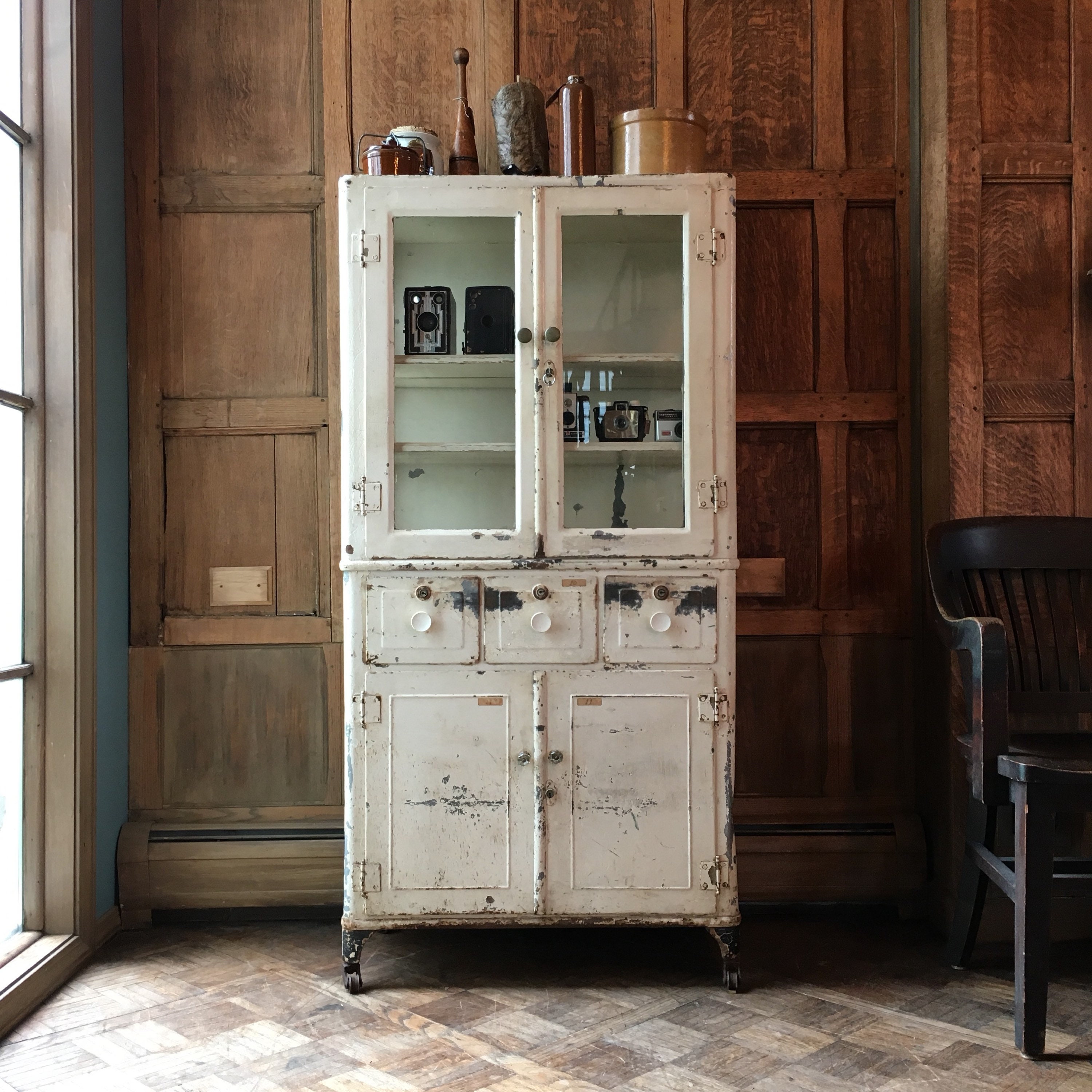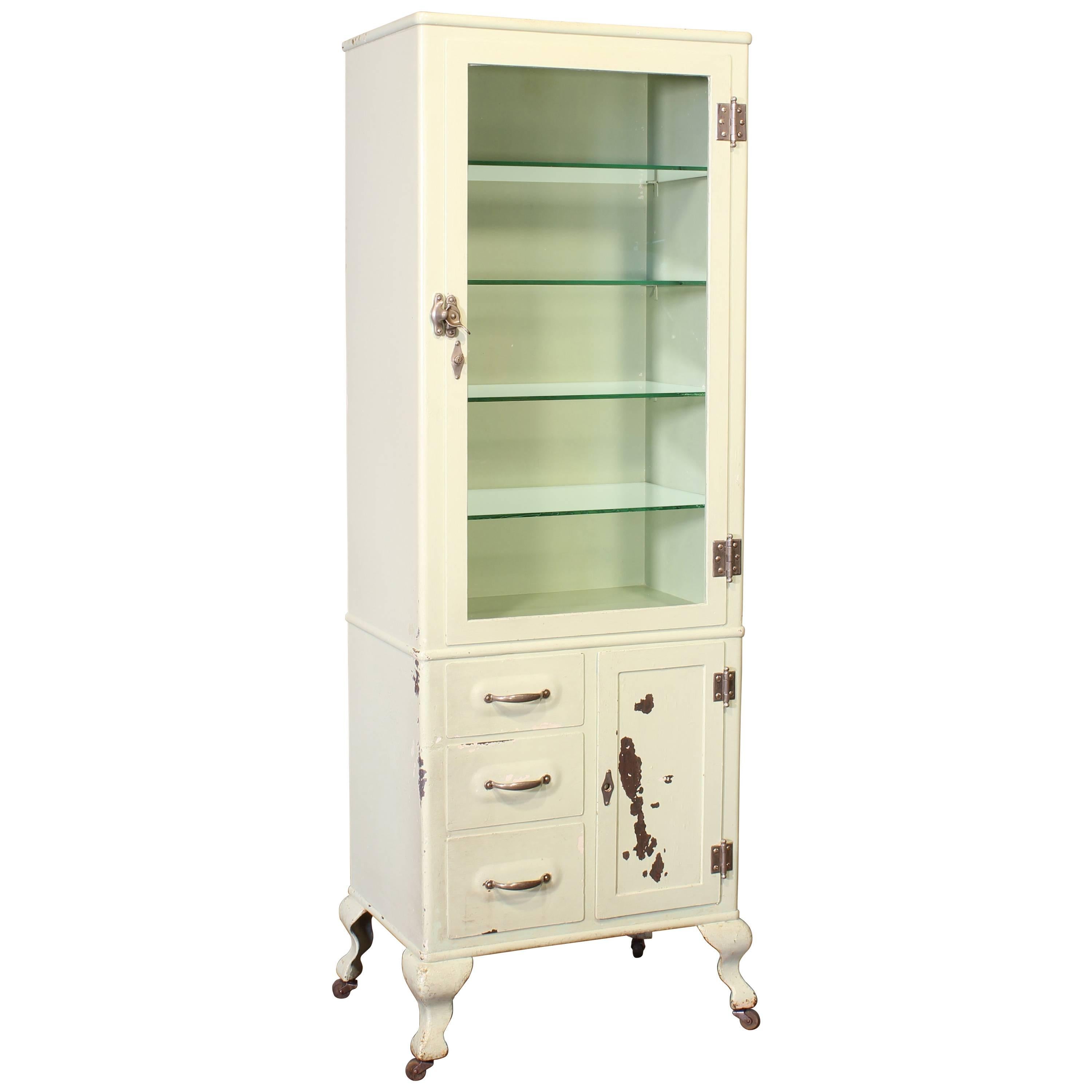History and Significance: Antique Corner Medicine Cabinet

Corner medicine cabinets, a ubiquitous fixture in bathrooms for over a century, hold a fascinating history that reflects evolving healthcare practices, design aesthetics, and domestic life. Tracing their origins back to the Victorian era, these cabinets reveal a compelling story of innovation, practicality, and changing societal needs.
Evolution of Corner Medicine Cabinets
Corner medicine cabinets emerged as a practical solution to space constraints in homes. Early forms, dating back to the late 19th century, were often simple wooden structures with shelves and a small, hinged door. These cabinets were primarily intended for storing basic medications and toiletries, reflecting the limited range of pharmaceuticals available at the time.
The use of corner cabinets for medicine storage was a logical choice, maximizing space in small bathrooms and providing a dedicated area for essential healthcare supplies.
As the 20th century progressed, corner medicine cabinets underwent significant transformations. The introduction of new materials, such as metal and glass, allowed for more elaborate designs and improved functionality.
- Early 20th Century: The use of mirrored doors became increasingly popular, adding a decorative element and enhancing the functionality of the cabinet. This era also saw the integration of lighting fixtures within the cabinet, providing better visibility for accessing medications.
- Mid-20th Century: The rise of modernism influenced design trends, leading to streamlined and minimalist corner medicine cabinets. These cabinets often featured sleek metal frames, frosted glass doors, and integrated lighting.
- Late 20th Century: The introduction of plastic and acrylic materials further expanded design possibilities, enabling the creation of lighter, more affordable, and versatile corner medicine cabinets.
Types and Styles

Antique corner medicine cabinets, often found in homes built before the mid-20th century, showcase a fascinating array of materials, styles, and regional variations. These cabinets were not merely functional storage units but also decorative elements that reflected the tastes and trends of their time.
Materials and Construction
The materials used in antique corner medicine cabinets reveal much about their era and intended use.
- Wood: Oak, mahogany, cherry, and pine were popular choices for medicine cabinets, offering durability and aesthetic appeal.
- Metal: Cast iron and brass were frequently employed for hardware and decorative accents, adding a touch of elegance and resilience.
- Glass: Mirrored doors were a common feature, adding functionality and reflecting the surrounding space.
Styles and Influences
Antique corner medicine cabinets reflect the evolving styles of their respective periods, from the ornate Victorian era to the sleek lines of Mid-Century Modern.
- Victorian (1837-1901): Victorian medicine cabinets often featured intricate carvings, elaborate hardware, and stained glass panels. They embodied a sense of opulence and grandeur.
- Art Deco (1920s-1930s): Art Deco cabinets embraced geometric patterns, bold colors, and streamlined designs. They reflected a modern aesthetic and a shift towards geometric forms.
- Mid-Century Modern (1940s-1960s): Mid-Century Modern cabinets were characterized by simplicity, functionality, and clean lines. They often featured minimalist hardware and integrated mirrors.
Regional Variations
Antique corner medicine cabinets also reveal regional variations in style and design, influenced by local materials, craftsmanship, and cultural preferences.
- New England: New England cabinets often featured hand-crafted details, simple designs, and durable construction, reflecting the region’s history of woodworking.
- Southern United States: Southern cabinets may have incorporated decorative elements like turned legs, ornate moldings, and intricate hardware, reflecting the region’s rich architectural heritage.
- California: California cabinets may have showcased a more modern aesthetic, influenced by the state’s embrace of Mid-Century Modern design.
Distinctive Features
The unique features of antique corner medicine cabinets offer clues to their origins and styles.
- Hardware: Handles, hinges, and latches often reveal the cabinet’s age and style. Victorian cabinets might feature ornate brass handles with intricate designs, while Mid-Century Modern cabinets might have simple chrome or brass handles.
- Ornamentation: Carvings, moldings, and decorative panels can add character and elegance to antique cabinets. Victorian cabinets often featured elaborate carvings, while Art Deco cabinets might have geometric patterns or stylized floral motifs.
- Mirrors: Mirrored doors were a common feature, adding functionality and reflecting the surrounding space. Victorian cabinets might have ornate frames, while Mid-Century Modern cabinets might have simple, integrated mirrors.
Examples of Notable Antique Corner Medicine Cabinets
Several notable antique corner medicine cabinets exemplify the evolution of style and design.
- A Victorian medicine cabinet from the late 19th century: This cabinet might feature intricate carvings, elaborate hardware, and stained glass panels. It would embody a sense of opulence and grandeur, reflecting the Victorian era’s fascination with intricate details.
- An Art Deco medicine cabinet from the 1920s: This cabinet might showcase geometric patterns, bold colors, and streamlined designs. It would reflect the modern aesthetic of the Art Deco period, with a focus on geometric forms and bold ornamentation.
- A Mid-Century Modern medicine cabinet from the 1950s: This cabinet might feature simple, clean lines, minimalist hardware, and an integrated mirror. It would embody the functionality and simplicity of Mid-Century Modern design, prioritizing clean lines and streamlined aesthetics.
Restoration and Preservation

Restoring and preserving antique corner medicine cabinets is a labor of love, requiring a blend of technical expertise, historical sensitivity, and ethical practices. The goal is to bring these charming relics back to their former glory while ensuring their longevity for future generations.
Restoring and Preserving Antique Corner Medicine Cabinets
Restoring and preserving antique corner medicine cabinets involves a delicate balance of respecting their history while addressing their wear and tear. The process begins with a careful assessment of the cabinet’s condition, taking note of any material deterioration, missing parts, and aesthetic inconsistencies.
- Material Deterioration: Over time, the wood can become dry and brittle, the paint can chip and fade, and the hardware can corrode. Addressing these issues requires a combination of gentle cleaning, wood restoration techniques, and appropriate paint and metal treatments.
- Missing Parts: Missing parts, such as hinges, knobs, or shelves, can pose a significant challenge. Sourcing authentic replacement parts is crucial to maintaining the cabinet’s original character. This often involves searching antique shops, online marketplaces, or specialized dealers. If finding exact replacements proves impossible, skilled craftspeople can sometimes create replicas that closely resemble the originals.
- Aesthetic Inconsistencies: Over the years, the cabinet may have undergone repairs or modifications that deviate from its original design. Restorers must carefully evaluate these changes and decide whether to retain them or restore the cabinet to its original state. This decision often involves weighing the historical significance of the modifications against the desire to preserve the cabinet’s authenticity.
Ethical Practices in Restoration
Ethical restoration practices are paramount in preserving the integrity and value of antique corner medicine cabinets. The focus should be on maintaining the cabinet’s original materials and construction techniques whenever possible.
- Minimal Intervention: Restorers should intervene only when necessary, avoiding unnecessary modifications or replacements. The goal is to preserve the cabinet’s original character and history, not to create a perfect replica.
- Reversible Treatments: Whenever possible, restoration treatments should be reversible. This allows future generations to undo any changes and access the cabinet’s original materials and construction techniques.
- Documentation: Thorough documentation of the restoration process is essential. This includes photographs, notes, and a detailed record of any repairs or modifications. This documentation provides valuable information for future generations and helps to preserve the cabinet’s history.
Sourcing Authentic Replacement Parts
Finding authentic replacement parts for antique corner medicine cabinets can be a challenging but rewarding endeavor.
- Antique Shops and Flea Markets: These are often excellent sources for original parts, particularly those from the same era as the cabinet. Patience and persistence are key, as finding the perfect match can take time.
- Online Marketplaces: Websites dedicated to antique and vintage items can be a valuable resource for finding authentic parts. However, it’s important to be cautious and verify the authenticity of the parts before purchasing.
- Specialized Dealers: Dealers who specialize in antique hardware or furniture restoration can be a valuable source of information and authentic parts. They may have access to rare or hard-to-find items.
Maintaining the Original Character
Restoring an antique corner medicine cabinet is not just about fixing its flaws; it’s also about preserving its original character.
- Respect for Patina: The patina, or natural aging, of the cabinet’s finish is a testament to its history. Restorers should avoid removing it completely, as it adds to the cabinet’s character and value. In some cases, a light cleaning or waxing may be sufficient to enhance the patina without altering its original appearance.
- Preservation of Original Features: Original features, such as hardware, hinges, and shelves, should be preserved whenever possible. If these features are damaged, they should be repaired or replaced with authentic replicas.
- Understanding the Cabinet’s History: Researching the cabinet’s history can provide valuable insights into its original use and design. This information can help guide the restoration process and ensure that the cabinet is restored to its authentic state.
The antique corner medicine cabinet, with its tiny drawers and frosted glass doors, held secrets of a bygone era. It whispered of remedies long forgotten and ailments now easily treated. Perhaps it’s time to modernize, to display those vintage treasures in a more prominent way, like in one of those beautiful oak glass fronted display cabinets that exude timeless elegance.
The medicine cabinet, though, will always hold a special place in my heart, a reminder of a simpler time and the enduring power of tradition.
An antique corner medicine cabinet, with its frosted glass and brass hinges, whispers of a bygone era. It’s a silent witness to countless remedies and whispered secrets, much like the server racks and cabinets that hold the digital heart of our modern world.
Choosing between a server rack vs cabinet is a decision based on practicality and necessity, just as the corner medicine cabinet was once a vital piece of household infrastructure. Though time has moved on, both objects hold a certain charm – a reminder of how we store and safeguard the things that matter most.
